 table_constraint::=
table_constraint::=
To define an integrity constraint. An integrity constraint is a rule that restricts the values for one or more columns in a table or an index-organized table.
CONSTRAINT clauses can appear in either CREATE TABLE or ALTER TABLE commands. To define an integrity constraint, you must have the privileges necessary to issue one of these commands. See CREATE TABLE and ALTER TABLE.
Defining a constraint may also require additional privileges or preconditions, depending on the type of constraint. For information on these privileges, see the descriptions of each type of integrity constraint in "Defining Integrity Constraints".
 table_constraint::=
table_constraint::=



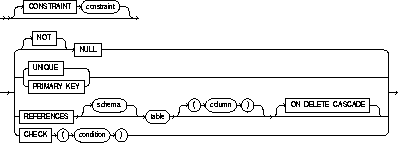 column_constraint::=
column_constraint::=


storage_clause: See the STORAGE clause.
CREATE TABLE dept (deptno NUMBER CONSTRAINT check_deptno
CHECK (deptno BETWEEN 10 AND 99)
DISABLE,
dname VARCHAR2(9) CONSTRAINT check_dname
CHECK (dname = UPPER(dname))
DISABLE,
loc VARCHAR2(10) CONSTRAINT check_loc
CHECK (loc IN ('DALLAS','BOSTON',
'NEW YORK','CHICAGO'))
DISABLE);
Relational table definition ::=

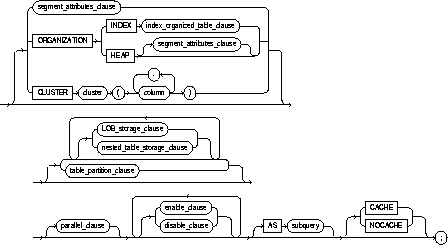 ,
,
 Object table definition ::=
Object table definition ::=


column_ref_clause::=
table_ref_clause::=
segment_attributes_clause::=
physical_attributes_clause::=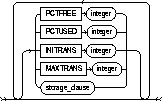
storage_clause: See the STORAGE clause.
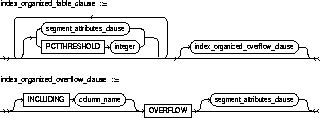

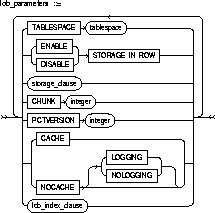




To define the EMP table owned by SCOTT, you could issue the following statement:
CREATE TABLE scott.emp
(empno NUMBER CONSTRAINT pk_emp PRIMARY KEY,
ename VARCHAR2(10) CONSTRAINT nn_ename NOT NULL
CONSTRAINT upper_ename
CHECK (ename = UPPER(ename)),
job VARCHAR2(9),
mgr NUMBER CONSTRAINT fk_mgr
REFERENCES scott.emp(empno),
hiredate DATE DEFAULT SYSDATE,
sal NUMBER(10,2) CONSTRAINT ck_sal
CHECK (sal > 500),
comm NUMBER(9,0) DEFAULT NULL,
deptno NUMBER(2) CONSTRAINT nn_deptno NOT NULL
CONSTRAINT fk_deptno
REFERENCES scott.dept(deptno) )
PCTFREE 5 PCTUSED 75;
This table contains 8 columns. The EMPNO column is of datatype NUMBER and has an associated integrity constraint named PK_EMP. The HIRDEDATE column is of datatype DATE and has a default value of SYSDATE, and so on.
This table definition specifies a PCTFREE of 5 and a PCTUSED of 75, which is appropriate for a relatively static table. The definition also defines integrity constraints on some columns of the EMP table.
To define the sample table SALGRADE in the HUMAN_RESOURCE tablespace with a small storage capacity and limited allocation potential, issue the following statement:
CREATE TABLE salgrade
( grade NUMBER CONSTRAINT pk_salgrade
PRIMARY KEY
USING INDEX TABLESPACE users_a,
losal NUMBER,
hisal NUMBER )
TABLESPACE human_resource
STORAGE (INITIAL 6144
NEXT 6144
MINEXTENTS 1
MAXEXTENTS 5
PCTINCREASE 5);
The above statement also defines a PRIMARY KEY constraint on the GRADE column and specifies that the index Oracle creates to enforce this constraint is created in the USERS_A tablespace.
For more examples of defining integrity constraints, see the CONSTRAINT clause. For examples of enabling and disabling integrity constraints, see the ENABLE clause and the DISABLE clause.
When using parallel query, the fastest way to create a table that has the same columns as the EMP table, but only for those employees in department 10, is to issue a command similar to the following:
CREATE TABLE emp_tmp NOLOGGING PARALLEL (DEGREE 3) AS SELECT * FROM emp WHERE deptno = 10;
Using parallelism speeds up the creation of the table because Oracle uses three processes to create the table. After the table is created, querying the table is also faster, because the same degree of parallelism is used to access the table.
The following example creates table LOB_TAB with two LOB columns and specifies the LOB storage characteristics:
CREATE TABLE lob_tab (col1 BLOB, col2 CLOB)
STORAGE (INITIAL 256 NEXT 256)
LOB (col1, col2) STORE AS
(TABLESPACE lob_seg_ts
STORAGE (INITIAL 6144 NEXT 6144)
CHUNK 4
NOCACHE LOGGING
INDEX (TABLESPACE lob_index_ts
STORAGE (INITIAL 256 NEXT 256)
)
);
Index-organized tables differ from other kinds of tables in that Oracle maintains the table rows in a B*-tree index built on the primary key. However, the index row contains both the primary key column values and the associated non-key column values for the corresponding row.
The following statement creates an index-organized table:
CREATE TABLE docindex
( token CHAR(20),
doc_oid INTEGER,
token_frequency SMALLINT,
token_occurrence_data VARCHAR(512),
CONSTRAINT pk_docindex PRIMARY KEY (token, doc_oid) )
ORGANIZATION INDEX TABLESPACE text_collection
PCTTHRESHOLD 20 INCLUDING token_frequency
OVERFLOW TABLESPACE text_collection_overflow;
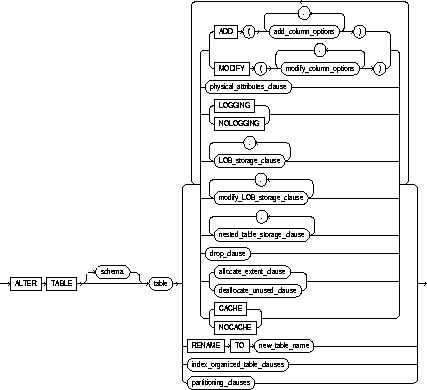

add_column_options::=
column_constraint, table_constraint: See the CONSTRAINT clause
column_ref_clause::=
table_ref_clause::=
modify_column_options::=


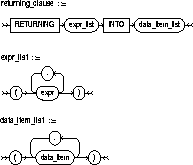
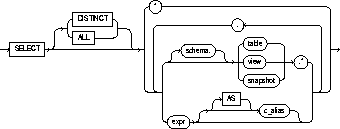
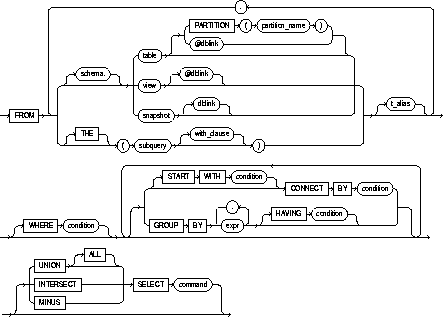
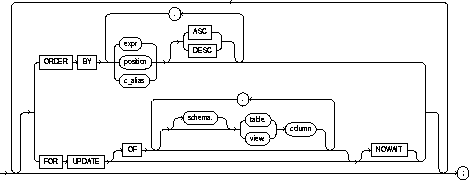
 WITH_clause::=
WITH_clause::=
